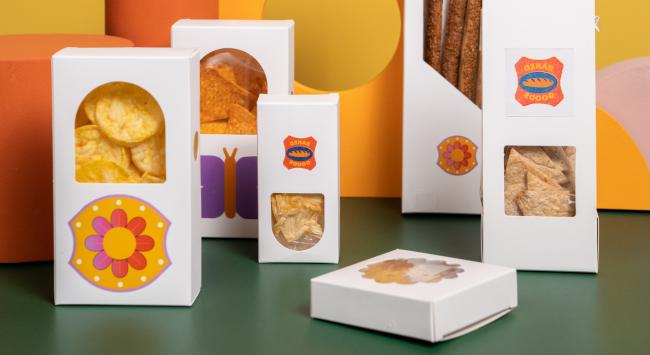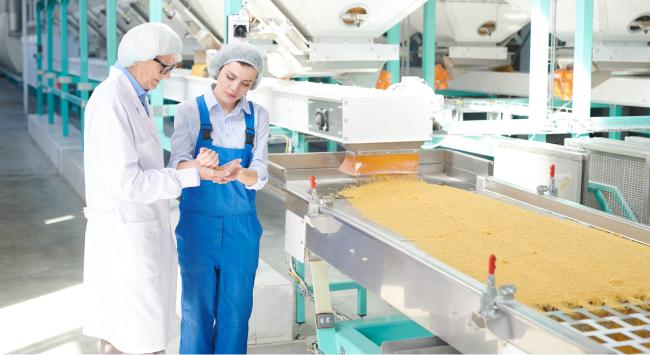
How To Make A Food Product – A Simple 11-Step Guide

Launching a new food product can be overwhelming, from perfecting your recipe to navigating regulations. Every successful food company once faced this challenge, knowing that the journey from concept to grocery shelves is filled with critical steps.
Our guide breaks down this complex process into 11 manageable stages, ensuring you craft a delicious product while staying on track. Dive in and transform your tasty idea into reality!
1. Understanding Food Product Development

Understanding food product development is crucial for creating a successful food business. This involves defining your food philosophy, setting business goals, and understanding the purpose of your product in the market.
Definition and Purpose
Developing food products is the process that takes a food idea from concept to market. It involves brainstorming, refining, and transforming an original food concept into a tangible product that can be mass-produced and sold.
This journey includes several stages such as ideation, market research, formulation, and consumer testing.
The purpose of this process is twofold: first, to create products that meet consumers’ needs and preferences; secondly, to ensure these new food items are safe for consumption and comply with all necessary regulations.
Food scientists play a vital role here by merging culinary arts with scientific principles to craft delicious yet safe products. Their contribution ensures each step—from sourcing ingredients to packaging design—is meticulously planned out for the success of the product in grocery stores and other outlets.
Importance of Food Philosophy
Understanding your food philosophy is much like crafting a mission statement for your product. It shapes every decision you make, from the source of your ingredients to how you market your brand.
A clear food philosophy sets you apart in a crowded marketplace and speaks directly to consumers who share your values. For instance, if sustainability is at the core of your beliefs, highlighting this can attract customers looking for eco-friendly options.
Developing a thoughtful approach to what and how products are made reflects on the overall quality and integrity of your business. It guides marketing strategies by defining who you are as a food brand, what you stand for, and why people should care about your offerings.
This integral step not only helps in carving out a distinct identity but also steers the direction towards which target market will likely resonate with what you bring to their tables.
Deciding Business Goals
Setting clear business goals is your roadmap to success in the food industry. Start by identifying what you want to achieve with your food business. Are you aiming for a certain number of sales, expansion into new markets, or maybe establishing a recognized brand? Define your objectives early and make sure they are specific, measurable, achievable, relevant, and time-bound (SMART).
This clarity will guide every decision you make – from production processes to your marketing strategy.
After pinpointing these ambitions, focus on how best to scale up operations without compromising quality or breaching safety standards and regulations. Your goals should align with maintaining high standards throughout scaling so that as your volume grows, customer trust remains solid.
With these targets in place, move on to understanding who will buy your product.
2. Identifying Your Target Audience

Choosing a niche and engaging with potential customers is crucial in identifying your target audience for your food product. Understanding the needs and preferences of your customers will help you tailor your product to meet their demands effectively.
Choosing a Niche
Identifying a niche is pivotal in the food product development process. Understanding your target audience and their specific needs helps you tailor your product to meet their demands, gaining an edge in a competitive market.
By conducting thorough market research and identifying gaps, you can find opportunities for innovation that align with your business goals. Analyzing trends and consumer behavior allows you to position your food brands strategically, maximizing its potential for success.
Understanding the nuances of choosing a niche empowers you to create products that resonate with consumers in the saturated food industry, setting the stage for a successful venture.
Engaging with Potential Customers
To engage with potential customers, utilize social media platforms and other online channels to gather feedback and insights on their preferences and pain points. This will help you tailor your product to their needs.
- Use surveys or polls to understand customer preferences and gather feedback for product development.
- Engage with potential customers through social media, forums, and other online communities to build relationships and gather insights.
- Attend food – related events or farmers’ markets to interact with potential customers in person and gather direct feedback on your product concept.
- Offer product samples or trials to potential customers for feedback collection and to generate interest.
3. Market Research and Idea Generation

Explore various ideas for your food product and conduct thorough market research to understand the needs and pain points of your target audience. Refine your ideas based on the insights gained and ensure that your product is feasible and economically sustainable in the long run.
Exploring Ideas
When exploring ideas for your food products, consider the latest food trends and consumer preferences in the market. Use market research to identify gaps or opportunities that your product can fill.
- Research popular food trends and emerging consumer preferences to understand what products are in demand.
- Use surveys, focus groups, and interviews to gather insights from potential customers about their unmet needs or desired improvements in existing products.
- Study competitor products to see what is already available in the market, and identify areas where you can differentiate your product.
- Brainstorm with a diverse team of professionals to generate innovative ideas and solutions for your food product.
- Experiment with different flavors, ingredients, and packaging options to create a unique selling proposition for your product.
- Consider sustainability, health benefits, convenience, and ethical sourcing when formulating your product ideas.
Analyzing Target Market and Pain Points
To create a successful food product, it’s crucial to analyze the target market and identify the pain points your product will address. Here are important steps to take:
- Conduct thorough market research to understand consumer preferences and behavior.
- Identify the specific needs or problems within the market that your product can solve.
- Gather feedback from potential customers through surveys, focus groups, or interviews to pinpoint their pain points.
- Analyze competing products and assess their strengths and weaknesses in addressing consumer needs.
- Use data analytics tools to gain insights into market trends and patterns related to your product category.
- Consider external factors such as economic conditions, demographic shifts, and industry regulations that may impact customer preferences.
Refining Ideas
To refine your ideas for a food product, consider these important steps:
- Gather feedback from potential customers to understand their preferences and needs.
- Conduct taste tests or product trials to gather data on flavor, texture, and overall satisfaction.
- Review market trends and competitor products to identify gaps or opportunities for improvement.
- Experiment with different ingredients, recipes, and packaging options to enhance the appeal of your product.
- Seek input from food scientists or experts to optimize the nutritional value and shelf life of your product.
- Consider consumer convenience and dietary restrictions when refining your product concept.
- Evaluate the feasibility of production at scale while maintaining product quality and consistency.
4. Ensuring Feasibility and Unit Economics

Evaluate your supply chain and production process, define your production targets, and analyze the short and long term unit economics to ensure the feasibility of your food product business.
Learn more about navigating through the complexities of making a food product by reading on!
Evaluating Supply Chain and Production
Evaluating the supply chain and production is crucial for food product owners. It involves thoroughly scrutinizing the entire production process to ensure efficiency, quality, and compliance with industry standards. Here’s how to do it:
- Assessing the reliability of suppliers and distributors is vital for maintaining consistent ingredient quality.
- Calculating production capacity based on demand forecasts helps in optimizing resources and meeting market needs.
- Analyzing cost structures, including raw material expenses, labor costs, and overheads, is necessary to establish unit economics.
- Implementing quality control measures throughout the production process ensures a high standard of the final product.
- Developing contingency plans for potential supply chain disruptions safeguards against unforeseen challenges.
- Optimizing transportation logistics to minimize lead times and maximize cost – effectiveness is essential for efficient distribution.
Defining Production Targets
After evaluating the supply chain and production process, it is essential to define production targets for your food product. Setting clear and achievable production targets ensures efficiency and consistency in manufacturing.
This involves determining the quantity of products that need to be produced within a specific timeframe, aligning with market demand and company resources. Factoring in crucial variables such as raw material availability, production capacity, and distribution capabilities will help in establishing realistic production targets.
Analyzing short and long term unit economics also plays a significant role in defining production targets. Understanding the cost structure associated with different levels of production will enable you to set viable targets that contribute to profitability while meeting market demands.
Meeting safety standards by creating a streamlined process for quality control should be an integral part of defining production targets. Ensuring compliance not only safeguards your consumers but also establishes trust in your brand, ultimately contributing to its success.
Analyzing Short and Long Term Unit Economics
Analyzing the unit economics of your food product is a fundamental step in ensuring its financial viability both in the short term and long term.
| Aspect | Short Term Considerations | Long Term Considerations |
| Cost of Goods Sold (COGS) | Calculate initial production costs, including ingredients, packaging, and labor. | Identify opportunities for bulk purchasing, automation, or process improvements to reduce COGS over time. |
| Price Point | Set a competitive introductory price to attract early customers. | Analyze market trends and adjust pricing strategies to ensure sustainable profit margins. |
| Revenue Projections | Establish realistic sales targets based on market entry. | Factor in market expansion, repeat customers, and scaling production capabilities. |
| Break-Even Analysis | Determine the number of units that must be sold to cover initial investment and ongoing expenses. | Reassess break-even points regularly considering potential changes in the market and cost structure. |
| Profit Margins | Ensure margins are sufficient to support operations and business growth. | Plan for reinvestment in the business and research and development for product innovation. |
| Cash Flow Management | Maintain a tight control on cash flow to manage day-to-day expenses. | Develop strategies for financial stability, managing debt, and funding future investments. |
It’s critical to keep in mind that these unit economic factors need regular reassessment as your business evolves. Up next, let’s delve into choosing the right channel strategy for your food product to maximize its reach and profitability.
5. Choosing the Right Channel Strategy
Consider various distribution channels such as online marketplaces, grocery stores, or specialty food shops to reach your target audience effectively. Evaluate the advantages and challenges of each channel before making a decision.
Analyze consumer behavior and preferences to align with the most suitable distribution strategy for your food product. Ensure that the chosen channel resonates with your brand’s philosophy and values.
Understanding the unique needs of each potential channel will help you determine which one best suits your product. Consider factors such as shelf life, packaging requirements, and shipping logistics when selecting a channel strategy.
Adapting your approach based on changing market trends and customer feedback is crucial in optimizing your distribution channels for long-term success.
Setting Up Production

Working with a food scientist or product developer is crucial in perfecting the recipe for your food product. Additionally, selecting a co-packer and sourcing high-quality ingredients are important steps in setting up production.
6. Working with a Food Scientist or Product Developer
When collaborating with a food scientist or product developer, ensure clear communication to convey your vision and goals for the food product. Utilize their expertise in food technology, ingredient functionality, and recipe formulation to enhance the quality and taste of your product.
Incorporate market insights into the development process to align the product with consumer preferences, ensuring its relevance and appeal in the market.
Engage in thorough discussions with the food scientist or product developer regarding regulatory requirements, shelf life testing, and packaging considerations. Additionally, leverage their knowledge in sourcing high-quality ingredients while balancing cost-effectiveness for sustainable unit economics.
7. Drafting a Product Memo
Craft the product memo with details about the recipe, ingredients, production process, and packaging requirements. Ensure that all aspects are clearly outlined to maintain consistency in production and quality control.
Detailing these elements will help in communicating effectively with your co-packer and suppliers, ensuring everyone is aligned on the vision for your food product.
Laying out clear and concise instructions within the product memo is vital for maintaining uniformity throughout the production process. This includes specifying ingredient sources, processing methods, quality standards, packaging specifications, and any other critical details relevant to producing your food item at scale.
Having a well-drafted product memo serves as a guiding document not only for initial production but also for future iterations or expansions of your food brand.
Perfecting this essential step sets the stage for smooth collaboration between you and those involved in bringing your food product to market while ensuring consistency in flavor profiles and overall quality.
With a comprehensive product memo in place, you lay a strong foundation for successful execution of your business goals related to launching a new or improved food product.
8. Selecting a Co-Packer
After finalizing the product memo, choosing the right co-packer is crucial for bringing your food product to life. Research potential co-packers and assess their facilities, production capabilities, and experience in your specific food category.
Ensure that the co-packer has a proven track record of quality, reliability, and adherence to industry standards. Verify their certifications and compliance with food safety regulations to guarantee a seamless production process.
When selecting a co-packer, consider their capacity to meet your production demands as you scale up. Understanding their lead times, flexibility in accommodating volume changes, and responsiveness to communication is essential for a successful partnership.
9. Sourcing Ingredients
When sourcing ingredients, ensure that they align with your food philosophy and business goals. Conduct thorough research to identify reliable suppliers who can provide high-quality raw materials for your food product.
Consider factors such as cost, availability, and the supplier’s commitment to sustainability and ethical practices. Additionally, secure samples of potential ingredients to test for taste, texture, and overall quality before committing to a supplier.
Another crucial aspect of ingredient sourcing involves ensuring compliance with food safety standards and regulations. Prioritize suppliers who adhere to industry guidelines and have proper documentation regarding the origin and handling of their products.
10. Registering Production with Authorities
After sourcing ingredients, the next crucial step in making a food product is registering production with authorities. It ensures compliance and legal operation. Here’s what you need to do:
- Research the specific regulatory requirements for food production in your area, including permits and licenses.
- Prepare all necessary documentation, such as business registration, health department certifications, and food handling permits.
- Submit applications for permits and licenses required to operate a food manufacturing facility.
- Implement comprehensive food safety measures and protocols to adhere to regulations and standards.
- Schedule inspections by relevant authorities to ensure compliance with health and safety guidelines.
- Establish quality control processes for consistent monitoring of production standards and compliance with regulations.
- Develop relationships with local health department officials to stay informed about any changes or updates in regulations.
11. Perfecting the Product Recipe
Creating a standout food product requires an exceptional recipe that delights the taste buds and keeps customers coming back. Start by experimenting with various ingredients and flavor combinations to find the perfect balance.
Consider factors like texture, aroma, and visual appeal when fine-tuning your recipe to ensure it aligns with your food philosophy while meeting customer expectations.
Once you’ve crafted a winning recipe, it’s essential to conduct thorough testing and gather feedback from potential customers or focus groups. This step can provide valuable insights into any necessary adjustments before finalizing your product recipe.
Remember, continuous improvement is key in perfecting your food product for market success.
Conclusion
In conclusion, developing a food product involves multiple steps, including understanding your target audience and conducting market research. Choosing the right channel strategy and setting up production are crucial components of the process.
Perfecting the product recipe and ensuring feasibility and unit economics are essential for success in this competitive industry.



